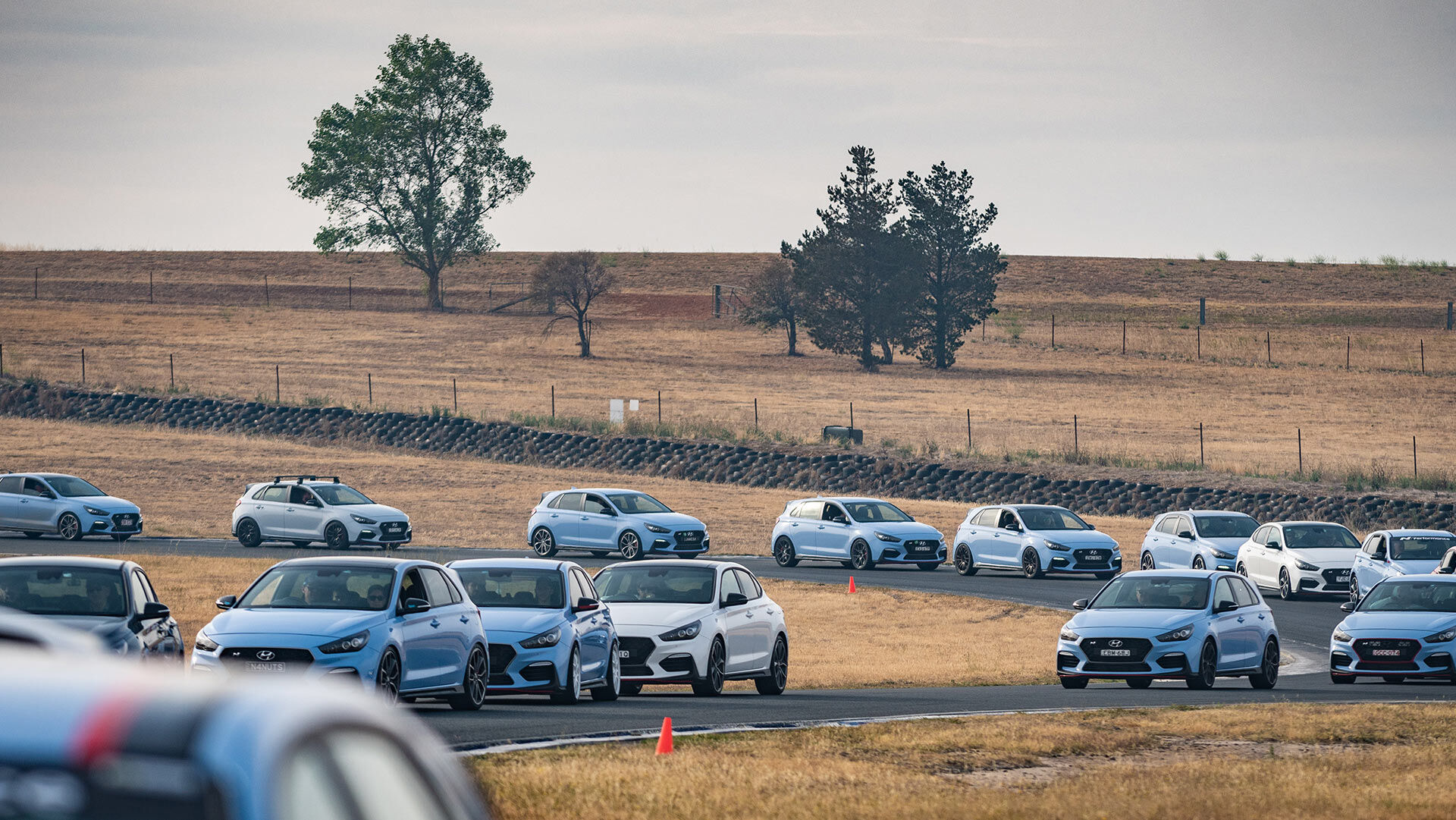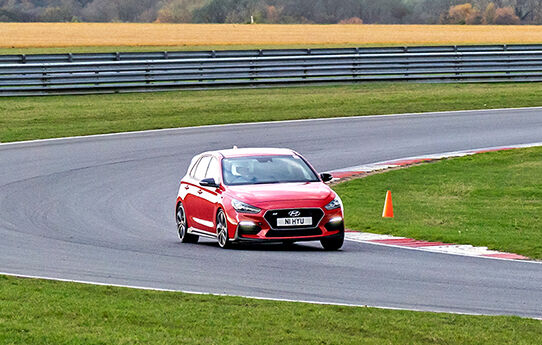26 March 2020
Still new to track racing and not sure how to prepare for a track day? Don’t worry, we’ll tell you all you need to know about track day so you know what to do before, between, and after your track day sessions so that you can fully enjoy the track day experience.
Table of Contents
Table of Contents Here
- 1. Before the Track Day
- Pre-check your car
- Clean your car
- Pack track day essentials
- Consider optional modifications
- 2. During and After the Track Day
- 3. Summary of Track Day Checkpoints
- 4. Track Driving with N
To be prepared for a track day, it’s a good idea to familiarize yourself with the timetable beforehand. You can check with your track day location and ask for their specific timetable. Usually, the sequence of events at a track day looks somewhat like this:
- Arrival and sign-in
- Safety briefing and safety check
- Sighting laps
- Circuit open for lapping
- Lunch break
- Circuit open for lapping
- Checkered flag: End of day


1. Before the Track Day
Every track day is exciting. When else do you get the opportunity to drive at super-fast speeds and take corners like a pro? Make sure you can enjoy track day without interruptions by taking care of a few things in advance.
Pre-check your car
Driving on a racetrack puts additional strain on your car, so you want to make sure your car is in good condition to guarantee safety and maximum performance on the track. When it comes to getting your car racetrack-ready, there are certain things you want on your track day checklist. If you’re a car pro, you can self-inspect your car; otherwise, we recommend you get advice from a mechanic you trust.
Generally, the older the car, the more thoroughly it needs to be checked — especially critical components of the car that guarantee safety. Make sure all the bolts and clips are tight and secure, and check the tightness of your engine mounts, gearbox mounts, subframe mountings, exhaust, steering rack, and suspension fixings. If any control lights are on, you should get them checked out.
After that, the car’s tires and wheels, brakes, fluids, engine, and battery need a thorough check.
Tires and wheels
Your tires and wheels will undergo intense driving conditions on the racetrack, so it’s extremely important that they’re in good condition.
First, you want to make sure your wheels are well-balanced. Vibrations you feel on a regular road will feel more extreme when racing on the track.
Then you want to check the tires’ tread depth. Tread depth is important for your car to function in all weather conditions and ensures your tires have sufficient ground contact even during heavy rain. Driving on the track with high speeds and driving through tight corners will cause stronger wear on your tires, so the tread depth and the condition of the sidewalls need to be checked regularly and before every track day. You can check your manufacturer’s manual for the optimal tread depth and instructions on how often the tires need to be replaced.
Another important checkpoint is tire pressure. Tire pressure is critical for your car’s performance, so it’s a must to check before your track day experience. You can start with the manufacturer’s recommendations and make small adjustments throughout the day to increase traction.

Brakes
The brakes are a crucial part of your car. On the racetrack, you reach faster speeds and do extreme cornering, so you need to make sure that your brakes are properly functioning to avoid any accidents.
Also, with more horsepower, your car needs stronger brakes and higher quality brake pads. Generally, your brakes should be in good condition, with no leaks as well as undamaged brake pads and rotors. Since brake pads experience stronger wear on the track, you want to make sure they have enough material left on them before a track day. In case of extreme wear, it’s a good idea to have a spare set of brake pads on hand. And while you’re checking the brake pads, don’t forget to check your brake fluid.
Learn techniques for faster and smoother braking



Fluids
When it comes to fluids – oil, water, etc. – you want to make sure to have them all topped up before your track day as the usage of fluids will be higher. If your oil is old, dark, and opaque, consider getting it flushed and changed.
Engine
The engine is the heart of your car, so you should check that your engine and transmission are in good condition, along with the engine oil and coolant to top it off or change it if necessary.
You won’t be allowed on the track if you have any leaks, so you should check for any potential leaks that could create dangerous conditions on the track.
For your car’s battery, make sure it’s secured with bolts for all the track racing action. Don’t forget to check that the positive battery terminals are covered to prevent a potential fire.

Noise level
Last but not least, remember to check the noise level of your car since there’s a noise limit at the track. If your car exceeds the noise limit, you won’t be allowed on the track, so it’s best to check and adjust beforehand to make sure your track day experience doesn’t get ruined by your car simply being too loud.
Clean your car
This might seem obvious, but it’s a very important part of your track day checklist to clean your car inside and out. This prevents loose objects from flying around. The inspection team at the track will also require you to remove everything from your car, so save precious track time and clean out the clutter beforehand.
Loose objects in your car are not only harmful, but they also weigh your car down, which lowers its performance. You want to remove any unnecessary weight, like that spare wheel or anything else you’re storing in your car.
Pack track day essentials
When it comes to what you’ll need to bring to the track, here’s a checklist to give you an idea.

Helmet
Most track day locations require you to wear a helmet. You might be able to rent one at the track, but if you plan to drive on the track frequently, you probably want to get your own. If you bring your helmet, make sure it has any required certifications.
Gloves
While gloves are often not required, they can be essential. When driving on the track, your hands can get sweaty due to the heat and adrenaline. Gloves can help increase your grip on the steering wheel, so you can go through corners like a pro. And gloves can protect your hands in the case of an accident or fire.
Tools
You never know what you might need on the track, so it’s a good idea to bring your toolbox to be prepared for any situation. Tools you need in your toolbox are a jack and jack stands, screwdrivers, foot pump, duct tape, cable ties, spanners, and hose clamps. Other useful items include:
- Torque wrench and wheel nut socket to make sure your wheels are properly torqued
- Tire pressure gauge to check your tire pressure
- Spare brake pads and sockets in case you need to replace your brake pads
Fluids
Be sure to bring extra oil and fluids. As mentioned previously, fluid consumption will be a lot higher than usual and your car will experience intense conditions, so you might need to top off the oil and fluids or flush the brakes with extra brake fluid. And not only fluids for your car — you should also bring enough drinking water to stay hydrated throughout the day.
Consider optional modifications
Any additional weight can slow down your car, so if you can, remove unnecessary things for the track day such as unnecessary seats, spare wheels, floor mats, etc. Besides reducing the weight of your car, consider investing in a pair of tires made for the track. With a spare set of tires for the track, you not only enhance your track day experience with sensational grip, you also won’t damage your regular tires that you need for the daily commute.

2. During and After the Track Day
There are a few things you should pay attention to during a track day.
Check fluid levels throughout the day due to higher fluid consumption. You can take some extra oil with you to top off if necessary. Be sure to check your tire pressure regularly to prolong the longevity of your tires, and you can slightly lower the tire pressure between sessions to increase traction — but don’t lower it too much.
After your track day session, it’s recommended to do a cool-down lap to get some air into your brakes, engine, and transmission as well as to let the car cool down. Without a cool-down lap, you might risk damaging your brake pads due to the heat. For that same reason, you also shouldn’t use the handbrake right after the session.
Once you’ve finished your cool-down lap, and once your tires have cooled down, you should check the tire pressure and tread depth to ensure that your tires are in good condition for the ride home.
After a track day, it’s a good idea to make a list of adjustments or additional tools you would like to bring for future track days. Every track day will give you more insight into how you can improve your car’s performance to be even faster the next time you hit the racetrack.
3. Summary of Track Day Checkpoints
There’s a lot of information here, so let’s quickly summarize.
Before track day, get your car checked out to ensure your car is ready for the track. Of course, you want to make sure that no control lights are on, that your tires and wheels and brakes are in good condition, all fluids are topped off, and your engine is in good shape. After that, you want to check that your car doesn’t exceed the noise limit, you’ve cleaned the car of any loose objects and your tank is full the day of the event.
It’s also important to be prepared for any situation, so bring essential tools from your toolbox, as well as a helmet, gloves, extra fluids, and drinking water.
During track day, make sure to continue checking the fluid consumption levels as well as your tire pressure and tread depth and to do a cool-down lap to let the car cool down and avoid any heat damage.
These steps will ensure that your car is ready to go out on the track. All that’s left after that is to enjoy it. Driving on track can be a wonderfully liberating experience – no speed limits, no oncoming traffic, and a safe environment to test your skills.
4. Track Driving with N
If you want to discover what your car can really do, the best thing is to take it on a track day. Contrary to what some people might tell you, virtually any well-maintained road car can be fun on a track; you don’t need any special modifications or upgrades to get started.
That’s particularly true of Hyundai’s N cars, which are designed to be track-ready right out of the box. In fact, so confident is Hyundai in the ability of these cars that it’s one of only a handful of manufacturers to include track day cover as standard in the warranty.
Even when you start to push harder, N’s got you covered. Many of the parts that more experienced track day drivers might consider as an upgrade to other cars can be supplied as standard on the Ns, such as an electronically-controlled limited-slip differential (standard on the Performance models).
If you’re looking for the best track car, check out the N models

If you’re interested in participating in one of Hyundai N’s track days, check out your local Hyundai Driving Academy.
Experience pure driving pleasure with Hyundai Driving Academy





